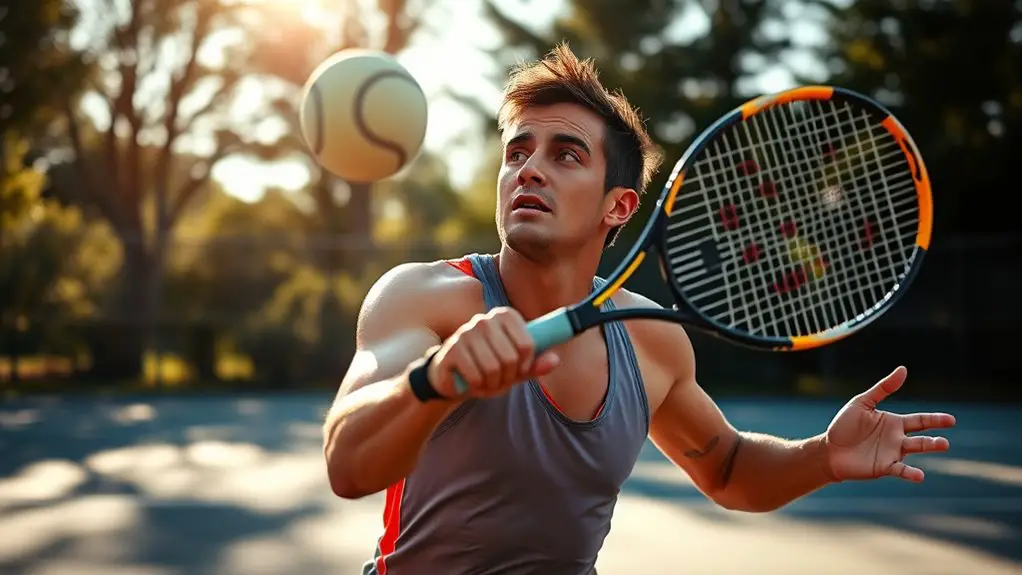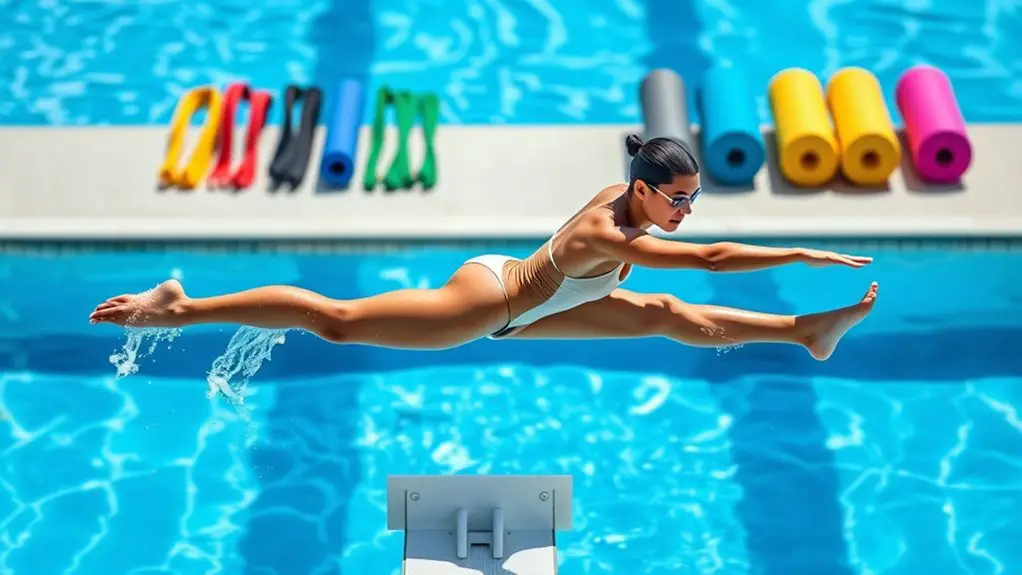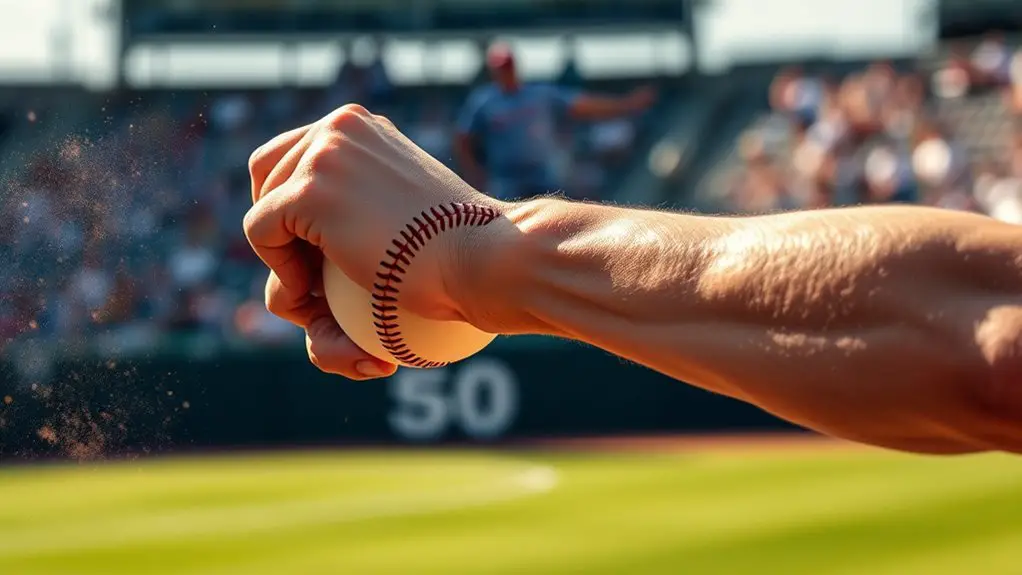To train for powerful, accurate serves, focus on your mechanics by generating power from your legs and maintaining a proper grip. Incorporate strength training exercises like squats and medicine ball slams to build explosive strength. Work on technique drills to improve consistency in your toss and follow-through. Don't forget to enhance your footwork for better positioning. Finally, use mental strategies like visualization to boost your confidence. There's much more to explore for mastering your serve!
Understanding the Mechanics of a Great Serve
A powerful serve can be a game-changer in tennis, setting the tone for the entire match. To harness this potential, you must understand the mechanics behind it. First, focus on the serve dynamics—how your body moves and interacts with the racket. Your legs generate the initial power, while your core and shoulders follow through, creating a fluid motion that maximizes speed.
Next, consider your grip influence. The way you hold the racket can greatly affect the ball's spin and trajectory. A continental grip often provides the versatility needed for different serves, allowing you to mix up your shots and keep opponents guessing.
Pay attention to your toss, as it sets the stage for a solid strike. By mastering these mechanics, you'll gain the freedom to express your unique style on the court and elevate your game to new heights. Incorporating strength training exercises into your routine can further enhance your serving power and stability.
Essential Drills for Developing Power
To hit powerful serves, you'll need to focus on a mix of strength training exercises and technique improvement drills. Incorporating targeted conditioning workouts can also enhance your overall performance. Let's explore some essential drills that will help you develop that much-needed power in your serves. Additionally, understanding the mechanics of a powerful punch can provide insight into generating more force in your serves.
Strength Training Exercises
Building explosive power for your serves requires targeted strength training exercises that focus on key muscle groups. By enhancing your core stability and developing explosive strength, you'll release your full serving potential. Here are essential exercises to include in your routine:
- Medicine Ball Slams: Boost your core and upper body power.
- Squats: Build leg strength, crucial for generating force.
- Deadlifts: Strengthen your posterior chain for improved stability.
- Rotational Cable Throws: Enhance your rotational strength for better serve mechanics.
- Box Jumps: Develop explosive leg power and agility.
Incorporating these exercises will give you the freedom to release powerful serves while maintaining balance and control on the court. So, embrace the grind and watch your serves soar!
Technique Improvement Drills
While strength training lays the foundation for powerful serves, technique improvement drills are essential for translating that strength into effective performance on the court. To enhance your serve rhythm, start with shadow swinging; this helps you focus on your motion without the ball. Next, practice your toss technique by using a target on the ground—aim for consistency in height and placement. Incorporate the "toss and catch" drill, where you toss the ball and catch it at the peak, ensuring you're comfortable with your toss. Finally, work on your follow-through; it can make or break your serve's power. These drills not only enhance your skills but also give you the freedom to express your unique serve style.
Targeted Conditioning Workouts
As you seek to develop the explosive power necessary for effective serves, targeted conditioning workouts play an essential role. These specific conditioning routines will elevate your game, enabling you to release your full potential. Here are some serve specific workouts to contemplate:
- Medicine Ball Slams: Build core strength and explosiveness.
- Plyometric Push-Ups: Enhance upper body power and stability.
- Sprints with Resistance Bands: Improve speed and acceleration for quick positioning.
- Kettlebell Swings: Boost hip drive and overall power generation.
- Single-leg Deadlifts: Develop balance and strength in your serving leg.
Incorporating these drills into your routine will empower you to serve with precision and force, giving you the freedom to dominate the court.
Techniques for Improving Accuracy
Improving your serve accuracy is essential for gaining an edge in any match, especially since a well-placed serve can unsettle your opponent right from the start. To enhance your serve placement, focus on hitting specific target zones on the court. Visualize these zones—left corner, right corner, and body shots. Each time you practice, aim for one zone at a time, and track your success rate.
Use a consistent toss height and angle to build muscle memory. Experiment with different grips and spins to discover what feels best for you. Incorporating targets during practice, like cones or markers, can sharpen your focus and precision.
Lastly, consider your rhythm; a smooth, relaxed serve helps maintain accuracy. By honing these techniques, you'll not only improve your serve's accuracy but also boost your confidence on the court, giving you that sought-after freedom to play your game.
Incorporating Footwork and Body Positioning
To effectively execute a powerful serve, you can't overlook the importance of footwork and body positioning. Your foot placement and body alignment play an essential role in generating power and precision. Here are some key points to reflect on:
- Start with a stable base: Position your feet shoulder-width apart for balance.
- Align your body: Face the net with your non-dominant shoulder, creating a strong stance.
- Shift your weight: As you toss the ball, shift your weight from your back foot to your front foot.
- Follow through: After striking, let your arm swing naturally, maintaining your body's alignment.
- Practice mobility: Incorporate drills that enhance your footwork, allowing you to move fluidly. Additionally, agility ladder drills can significantly improve your overall foot speed and coordination.
Mastering these elements can set you free to release your serving potential, making your serves not only powerful but also accurate. Embrace the freedom that comes from confident footwork and positioning!
Mental Strategies for Serving Success
While physical technique is essential, the mental aspect of serving can make or break your performance on the court. To harness your full potential, focus on visualization techniques. Picture yourself executing the perfect serve—imagine the ball soaring over the net, landing exactly where you want it. This mental imagery can boost your confidence and prepare you for success.
Building mental resilience is vital too. Embrace challenges during practice and learn to bounce back from mistakes. Instead of dwelling on errors, use them as opportunities to grow. When you face pressure, remind yourself of your training and visualize that perfect serve again. Integrating meditation techniques can also help you maintain clarity and focus during critical moments.
Stay present during matches; let go of past points and keep your focus on the next serve. With these mental strategies in place, you'll not only enhance your serving skills but also enjoy the freedom that comes with a confident mindset on the court.
Analyzing and Adjusting Your Serve Based on Feedback
As you work on perfecting your serve, feedback from coaches, peers, and even your own observations can be invaluable. Embrace this information as it creates feedback loops that help refine your technique. Here's how you can analyze and adjust your serve based on what you learn:
Feedback from coaches, peers, and self-reflection is essential for refining your serve technique. Embrace these insights for continuous improvement.
- Video Review: Record your serves to spot inconsistencies.
- Coach Insights: Regularly consult your coach for tailored advice.
- Peer Feedback: Encourage teammates to share their thoughts on your serve.
- Self-Reflection: After practice, jot down what felt right or wrong.
- Experimentation: Don't hesitate to try different grips or stances based on feedback.
Additionally, remember that embracing struggle is key to developing mental toughness, which can significantly enhance your performance and consistency in serving.
Frequently Asked Questions
How Often Should I Practice My Serves Each Week?
You should aim for a consistent practice frequency that fits your schedule and keeps you motivated. Ideally, practicing your serves three to four times a week can help you see real improvement. Just remember, it's not about cramming; it's about consistent, focused practice. Find a rhythm that feels right for you, and don't hesitate to mix it up to keep things fresh and enjoyable while you hone your skills.
What Type of Ball Is Best for Serving Practice?
Did you know that using a lighter ball can improve your serving speed by up to 10%? For serving practice, consider using training balls designed specifically for this purpose. They're typically lighter, which helps you focus on your technique without the weight of regular balls holding you back. Plus, the right ball weight can enhance your control and accuracy, giving you the freedom to experiment and refine your serve with confidence.
How Can I Prevent Injury While Serving?
To prevent injury while serving, you've gotta prioritize injury prevention in your routine. Start with proper warm-up routines that include dynamic stretches for your shoulders, arms, and legs. Focus on good technique to avoid unnecessary strain and fatigue. Incorporate strength training to build your muscles and enhance stability. Remember, it's about enjoying the game without setbacks, so listen to your body and give yourself time to rest when needed.
Should I Serve the Same Way in Matches and Practice?
Did you know that players who maintain match consistency in their serves often win 70% more points? You should definitely serve the same way in matches and practice, but don't shy away from incorporating serve variations. This keeps your opponents guessing and helps you adapt to different situations. By making practice feel like a match, you'll build confidence and freedom in your technique, leading to better performance when it counts.
How Do Weather Conditions Affect My Serve?
Weather conditions can really impact your serve. Wind resistance can alter the ball's trajectory, making it trickier to control. If you're on a hard court, the surface can affect your ball's bounce, while grass or clay surfaces might change your timing and spin. You've got to adapt your technique based on these factors. Embrace the challenge, and you'll find a way to harness the elements to your advantage!




